Northern New England Sled Dog Trade Fair
The Northern New England Sled Dog Fair takes place in New Hampshire every October. It’s a great weekend for mushers. Friends reconnect, supplies are abundant, and speakers are brought in to educate sled dog lovers. This year, one of the speakers was Dr. Donna Gigliotti DC. She is an animal chiropractor and she had a wealth of information to share with the attendees. All the dogs she came in contact with gave their seal of approval. Some of her insights were quite surprising. My husband Kevin has written up some of his observations and reactions to her presentations. Here is his take on Dr. Donna’s sometimes surprising diagnoses.
A brief word about horses’ derrieres…
Imagine a horse whose derriere is out of alignment. One side is noticeably higher than the other. The horse has a visible limp when viewed from behind. What would you conclude the problem is? I would conclude that the problem has something to do with the horse’s derriere. Well, according to the animal chiropractor who just spoke, the horse’s derriere might very well be the manifestation of the problem but the horse’s jaw is more likely to be the cause of the problem. Evidently, when a horse’s jaw is out of alignment, all the muscles along one side of the horse’s body become misaligned, including the horse’s derriere.
Now I don’t know a thing about horses’ derrieres. Well that’s not exactly true. I know a little bit about horses’ derrieres having dealt with certain members of congress during my working career. So I should say that I don’t know anything about real horses’ derrieres. No, no, let me rephrase that because I knew some real horses’ derrieres. I should have said: I don’t know anything about the derrieres of real horses. Isn’t it interesting how word order makes a difference?
Anyway, there’s a moral to this story. Well, actually there are two morals to the story. The first is: beware of answers that seem obvious. The second is: horses’ derrieres are often difficult to deal with.
Mushers worry about their dogs all the time. They watch their dogs like hawks looking for signs that anything might be wrong, especially out on the trail. And sometimes they see behavioral anomalies e.g., a slight limp, a changed eating habit, a tail that’s not wagging as much as usual. The animal chiropractor did a wonderful job of sensitizing the mushers to the fact that, although they are pretty good at noticing anomalous behavior, they are not as good at identifying causes. Often times, it’s a horse’s derriere kind of problem i.e., the cause is not the obvious one.
Here is one quick example. Dogs use their toenails, particularly the toenails on their front paws, to sense whether they are going uphill. If the nails do more than brush against the ground when the dog is walking normally on level ground, his paws send a signal to his brain that the terrain is uphill and he should shift more weight onto his hind legs. Now, suppose that you never trim the dog’s front toe nails. As they get longer and longer, they begin to contact the ground more and more. As they begin to contact the ground more and more the dog begins to sense that he is walking uphill and shifts more and more weight onto his back legs. Before long, when he’s walking on level ground, he looks as though he’s walking uphill – and he’s putting unusual stress on his hindquarters. If this goes on for a while, the dog develops an abnormal gait.
Here’s another example. Dogs use their tails for balance. If a dog’s tail is always off to one side when he walks, he might be using it to counteract a problem on the other side of his body e.g., his right front ankle is bothering him so the tail drifts to the left side to help get weight off the problem ankle.
As always, I find stuff I learn at mushing events to be related to golf. It was fascinating to watch the animal chiropractor observe a dog walking back and forth in front of her, describe the problem she sees, and explain the non-obvious cause of the problem. Similarly, I’ve watched many a golf professional observe an amateur hitting a golf ball and point out a minute grip problem that is causing the errant shot. In other words: It’s not the way you are swinging, it’s the way your grip is causing you to swing.
The bottom line is: It’s fun watching people who are good at what they do.
Here are a couple of pictures I took of the day’s events:
This is the Animal chiropractor examining one of the dogs…
The other dogs watched with interest…
Malamutes always seem to have this “Oh, well, I guess I’m next” look on their faces. Not hard to see why they are called “Fuzzies” by some mushers…
Then he thought to himself “Maybe I just need a nap…” Not a worried bone in this dog’s body…
This guy watched intently…
And then he relaxed when he saw how gently the other dogs were treated…
On the other hand, this guy was looking for an escape. Look at that tongue. Here is a happy dog that simply has better things to do. This is the Siberian Husky’s classic “I’m-outta-here-at-the-first-opportunity-look”…
I’ll tell you about the session with the Yukon Quest champs in the next bulletin.
Later,
The One-Man Pit Crew
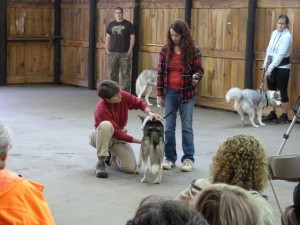

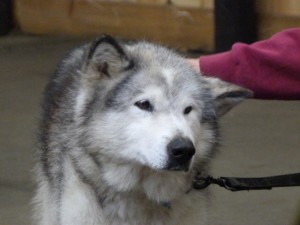

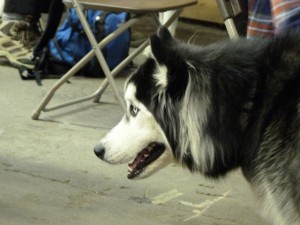
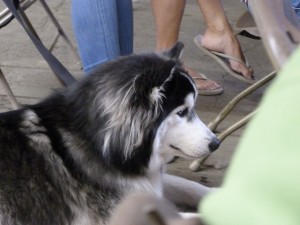
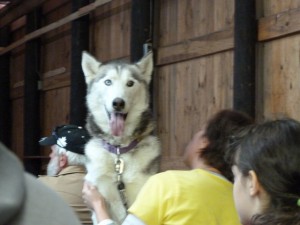
Very nice, Kevin! And funny and interesting too!!!
Linda
Kevin, This is a great overview! Thanks so much for taking the time to put what you saw and learned into words.